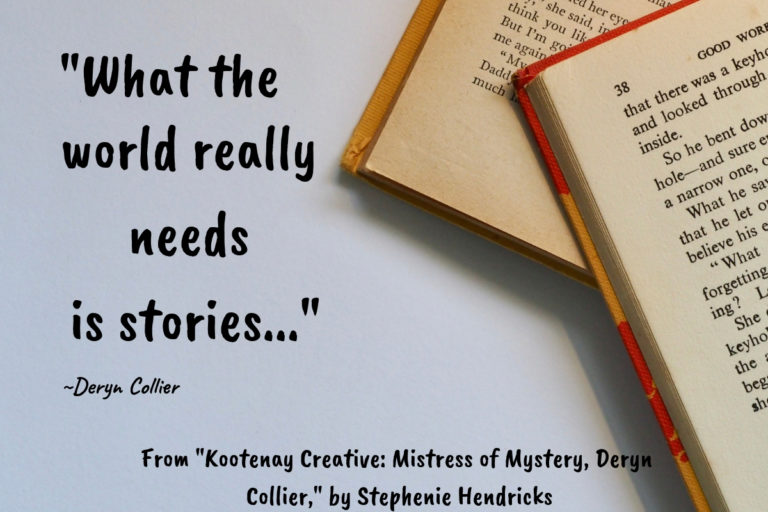The directions were methodical: Drive down one street, turn at another, then another, then go down a dirt lane, park my car just so. Then I was to enter a gate, traverse a yard, and find a mysterious red door and announce my arrival. Moving slowly, I was nervously hoping that I would be able to complete my mission successfully – to deliver an interview with Kootenay mystery writer Deryn Collier for the Black Bear Review. Bern Fortin, a protagonist in two of her books, ran through my mind as I approached said red door. Would I find a hunky Afghan war veteran lurking about? The door opened, and my anxiety dissipated as Deryn greeted me with a warm smile. Far from the troubled small town coroner in her mysteries, Deryn is grounded and friendly. With a great generosity of spirit, she opened up to reveal the alchemy she conjures when creating intriguing worlds for mystery aficionados.
Deryn’s open heartedness was apparent in the writing workshop where I first met her. Held at Mir Center, “Stone’s Throw” was a collaboration between Selkirk College and Eastern Washington University to bring professional writers together with aspiring student writers. Selkirk professors Renee Jackson-Harper and Almeda Glenn Miller made this event happen, and provided this wonderful reward as part of their robust teaching magic. Deryn, author of Confined Space (Simon and Schuster 2012) and Open Secret (Simon and Schuster 2014), engaged a room full of student mystery writers with valuable information and encouragement. Later on, when the request came to interview a “Kootenay Writer” for the Black Bear Review, I didn’t hesitate to ask specifically for this assignment.
The space where Deryn writes is enormously important to her, and she has worked hard to earn that space and the time to write. She led me upstairs to a bright and airy studio that was astonishingly lacking in clutter. It emanated a fresh energy that felt as though there was ample room to think and let one’s creativity flow. Deryn’s imagination gets a good work out here. She’s a long way from Montreal, where, as a young girl, she read the Nancy Drew mystery series.
Following the classic young detective sparked a lifelong fascination with the mystery genre. While attending McGill University and enduring a series of different kinds of jobs, she read voraciously, using her work experiences to inspire characters, plots, and settings. When her two sons were young, she continued her passion for reading and carved out time and space for writing. “I had to learn to be a real bulldog with my time,” she declared. Now that her sons are pretty much self-sufficient teens, she has manifested precisely the environment she wants for the mystical process of putting imagination to paper. Deryn constructs her writing on pages that she can lay out, much as an architect would lay out drafts for designing a building. She explained, “For me it’s very physical – like the having the physical paper out and stretched across eight feet of a table. It just gives my mind and my imagination a place to go. It’s much more than [what one can do on] a spreadsheet on a laptop, I just don’t feel that same freedom. I have highlighters around; there’s lots of tape or scissors and little cups of all different colored markers. I’m constantly playing with paper to work out my ideas before they go into a story.”
As important as the physical space is to Deryn for her writing, the places and settings for her Bern Fortin novels are woven with the culture, geography and “place” of the Kootenays. She lives in Nelson now, but previously lived in Creston for 15 years. In the Bern Fortin books, she invented a sort of hybrid Kootenay town called Kootenay Landing. This mythical creation that embodies real Kootenay themes has her readers guessing: “I love that when I’m talking with readers from Nelson, they think it’s Nelson. I had somebody write me [to tell me] they were convinced it was Invermere. People in Creston of course have taken complete ownership of these books but then they are [asking] why am I moving the streets around? Why am I making it quieter than and actually is? It’s kind of quaint like Nelson but its geography [is] flat .. I’m definitely playing with the place.”
Taking in the responses from her readers is part of Deryn’s process for writing. When it became clear to her that social media couldn’t provide the right venue for the kind of engagement she wanted with her audience, her solution was to set up a series of back and forth letters with fans through her website. In the letters she wrote, she shared her adventures with her research, photos that inspired her storylines, and other writing particulars. Readers can sign up to read the archived letters through her website. She advises writers starting out to get feedback on their own writing, through writer’s groups and with those who share a love of the craft.
In addition to creating a physical space and engaging in feedback with her audience, Deryn has developed an array of other strategies to support her writing process. Once she has entered her writing studio, she has a series of things she does before actually focusing in on the project at hand. She turns off the internet and her phone, and might use a special pen. “ [I have] little habits and little daily practices. First I free write for 10 minutes and then I light a candle and then I put on music and then I start my actual writing for the day. Sometimes those little rituals can take a long time depending on how settled and how ready I am to get into the space of writing.”
Our conversation covered a broad scope of things, including coping with disturbing events in the outside world and challenges in the competitive struggle of publishing. For Deryn, writing is a way of coping. “What the world really needs is stories, and these stories are meant for sharing and we’re all hungry for stories,” she explains. “If you’ve been given the golden ticket that says ‘writer,’ [and] you know that you’re a writer, then you need to be writing regardless of … whatever it is. I think it’s important to keep writing and keep getting better at writing and let that [other] stuff sort itself out.”
As I leave her special writing space, I reflect on her description of it: “I like to think that the story is alive in here. This is where the story lives and I come and go and the stories remain here.” Deryn has several projects in process, and for those of us who can’t wait to read them, we can go to www.deryncollier.com and sign up to be the first to know.
About the Author
Stephenie is a Peace and Justice Studies program student at Selkirk College. She has taught journalism and social justice communications at Dominican University of California where she received a Masters in Humanities with an emphasis on creative writing. She works as a communications consultant for advocates in the environmental health movement, and is planning to start a project documenting the heroes and sheroes in that movement using a literary nonfiction style beginning next year.

